Handmade pottery can contain lead, especially if it's vintage, imported, or decorated with bright colors. While not all handmade pieces are dangerous, there's a real risk that traditional glazes and production methods might include lead, which can leach into your food and beverages. You'll want to be particularly cautious with antique pieces, items from countries with loose regulations, or pottery showing signs of wear like chalky residue. Your best bet is to purchase from reputable manufacturers who follow FDA standards or test suspicious pieces with a lead testing kit. For your family's safety, it's worth taking a closer look at what's in your kitchen cabinets.
What Makes Pottery Dangerous
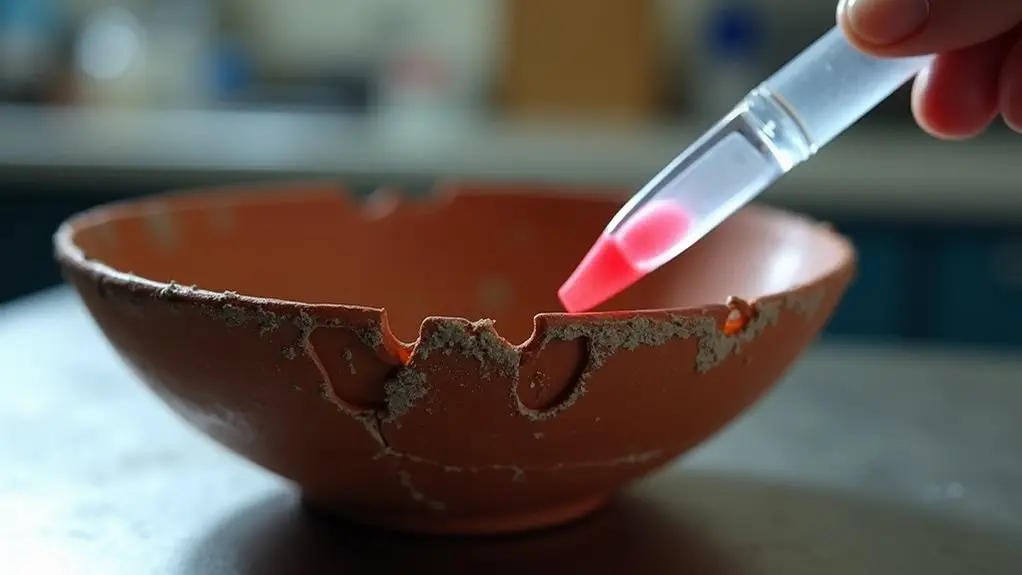
While pottery can beautify your home and dining experience, certain ceramics pose serious health risks due to their materials and manufacturing processes.
You'll want to pay special attention to pottery safety, particularly when it comes to glazes containing lead, which can seriously impact your health.
Traditional pottery and older pieces made before modern health regulations often contain lead glazes that can leach into your food.
You're most at risk when using highly decorated pieces, especially those with bright colors or decorations on the inside surfaces. Children are particularly susceptible and may suffer from lower intelligence scores when exposed to lead from pottery.
What's particularly tricky is that dangerous pottery isn't always obvious – those beautiful antique dishes or that charming handmade bowl from your travels could be harboring hidden hazards.
The real concern lies in corroded glazes and decorations applied on top of the glaze rather than beneath it.
Common Sources of Lead
Beyond pottery, lead lurks in numerous everyday items you mightn't suspect.
You'll find various lead sources in vintage household items, including old ceramic dishes, brass fixtures, and leaded crystal that might be hiding in your china cabinet.
Even your water pipes and faucets could be silent culprits. Acidic foods can make lead exposure worse when served in questionable dishes.
When it comes to pottery types, it's not just handmade items you need to watch out for.
Lead can show up in traditional ceramics, especially those from other countries where regulations aren't as strict.
You might also encounter lead in surprising places like imported spices, folk medicines, and even some cosmetics.
Don't forget about outdoor sources – soil near old buildings, air pollution, and dust can all harbor this sneaky toxin.
Being aware of these common sources helps you make safer choices for your home.
Testing Your Pottery at Home
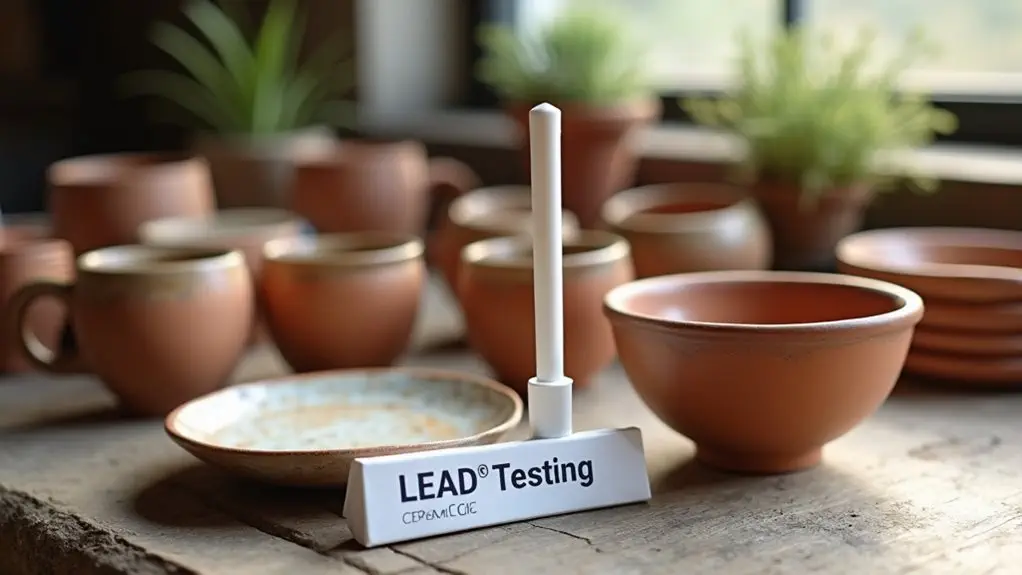
You'll want to start by picking up a reliable lead test kit, which you can find at most hardware stores or online retailers.
Once you've got your kit, you'll need to carefully follow the testing instructions and watch for any color changes that signal lead content in your pottery.
It's important to know that if your pottery tests positive for lead, you'll need to stop using it for food right away – no amount of washing or cleaning can make it safe. The 3M™ LeadCheck™ Swabs are a good choice since they're EPA-recognized for reliable results.
Lead Testing Kit Methods
Testing pottery for lead at home presents significant challenges and limitations.
While you might be tempted to grab a store-bought lead testing kit, you'll need to know about some important testing limitations. Most home test kits are designed for testing house paint, not ceramics, and their kit accuracy can be questionable when used on pottery.
You shouldn't rely solely on swab tests, as they often can't detect low levels of lead in high-fired ceramics, even when lead is present. Organizations like Lead Safe Mama use professional-grade XRF equipment for accurate testing of consumer goods.
For the most reliable results, you'll want to contemplate professional XRF testing or sending your pieces to an accredited laboratory.
If you're determined to use a home testing kit, look for EPA-recognized options like LeadCheck or D-Lead, but remember that they're not foolproof for testing ceramics.
Safety Check Warning Signs
When examining pottery for potential lead hazards, several visible warning signs can alert you to possible risks.
Your pottery care routine should include checking for these telltale indicators of potential lead exposure, especially if you've picked up pieces from flea markets or antique shops. Using home testing kits from hardware stores can help detect lead presence in questionable pieces.
Watch out for these key warning signs:
- Chalky-grey residue or deteriorating glaze that's flaking or showing signs of corrosion
- Bright orange, red, or yellow decorations, particularly on pieces with a handmade appearance
- Missing manufacturer information or warning labels on the bottom stating "Not for Food Use"
- Irregular shapes, crude craftsmanship, or damage to the pottery's surface
You'll want to be extra cautious with pieces made before the 1970s, as they're more likely to contain unsafe levels of lead in their glazes.
Interpreting Test Results
Once you've purchased a lead testing kit, understanding the results is essential for determining whether your pottery is safe for use. When you follow the kit's instructions, you'll notice the swab changes color if it detects lead on your pottery's surface.
For ideal test accuracy, you'll want to check the same spot multiple times – think of it as giving your pottery a thorough investigation!
Keep in mind that while these kits are helpful for lead detection, they're not foolproof. They can't measure exact lead amounts or detect what's lurking beneath the surface. FDA safety standards require more rigorous laboratory testing methods for definitive results.
If you get a positive result, it's best to retire that piece from food service. And here's the thing: even a negative result doesn't guarantee complete safety.
When in doubt, it's better to be safe than sorry – consider getting professional laboratory testing for precious pieces.
Health Effects of Lead Exposure
Lead exposure poses severe health risks across all age groups, from unborn babies to adults.
You'll want to understand these health implications, as they can affect your family in serious ways. From developmental delays in children to high blood pressure in adults, lead's impact on your health isn't something to take lightly.
Long-term exposure to lead can cause permanent neurological damage and learning disabilities in children.
Here's what you need to know about lead exposure's effects on your body:
- Your brain function can suffer, leading to memory problems and mood changes.
- Your digestive system might rebel with nausea and stomach pain.
- Your blood pressure could rise, affecting your heart health.
- Your unborn baby could face developmental challenges if you're pregnant.
Don't worry – knowledge is power!
Identifying High-Risk Pottery Pieces
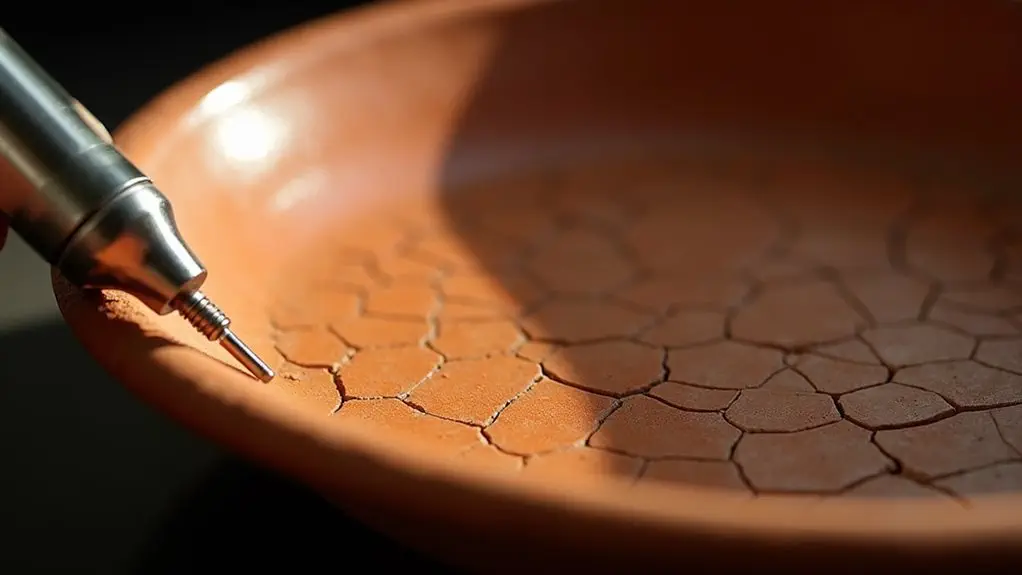
When you're checking your pottery for potential lead hazards, you'll want to look out for obvious visual clues like bright yellow or orange glazes, chips, cracks, or a crude, handmade appearance.
Modern pottery created with food-safe glazes is much safer for everyday use. If you've got pottery that's been passed down through generations or picked up at flea markets, it's especially important to use a lead testing kit before using these pieces for food or drinks.
You can't always trust your eyes alone, so testing older pieces and those from countries with less strict manufacturing standards is your safest bet to protect your family's health.
Visual Warning Signs
Identifying potentially dangerous pottery requires attention to several key visual indicators.
When you're conducting a visual inspection of pottery pieces, there are clear signs that should raise concerns about potential lead content. Your pottery aesthetics assessment should focus on these warning signs:
- Bright orange, red, or yellow decorations with unusually vibrant or intense coloring
- Rough, uneven glazing or pieces with visible cracks and damage
- Handmade items with irregular shapes or crude appearance, especially from less-regulated countries
- Missing or unclear safety labeling about food use
You'll want to be particularly cautious with antique pieces or pottery from flea markets and street vendors. Early Niloak pottery is known for its swirled glaze patterns which often contained potentially toxic materials during manufacturing.
If you spot these warning signs, it's best to avoid using these items for food or drink, as they might contain harmful substances.
Testing Old Ceramics
Because testing old ceramics can mean the difference between safety and potential lead exposure, understanding proper testing methods is essential.
When it comes to pottery safety, you've got several reliable options to check your pieces. While professional XRF analyzers offer the most accurate ceramic testing results, you can also use EPA-approved home test kits like 3M LeadCheck Swabs for a quick assessment. According to a 2007 study, over half of kits produced unreliable false negative results.
You'll want to pay special attention to certain high-risk items: traditional Latin American terra cotta, antique dishes made before 1971, and brightly decorated imported pieces from South America or Asia.
Don't forget to test multiple spots on each piece, since lead content can vary across the surface. If you're dealing with cherished family heirlooms, consider professional laboratory testing for the most definitive results.
Safe Pottery Shopping Guide
Since lead contamination remains a serious concern in handmade pottery, knowing how to shop safely can protect you and your family from potential health risks.
Today's pottery regulations have evolved to guarantee safe materials are used in commercial production, but you'll still need to be vigilant when shopping. Modern porcelain and stoneware clays are generally lead-free and safe for everyday use.
When you're looking for lead-free pottery, follow these essential guidelines:
- Shop from reputable manufacturers who comply with ASTM C738-94 standards
- Look for clearly labeled, non-toxic glazes like Mayco Stroke and Coat
- Check for warning labels that indicate "Not for Food Use"
- Consider using lead test kits for verification, especially with handmade pieces
You don't have to give up your love for unique pottery – just make smart choices and stay informed about safety standards.
Understanding Pottery Safety Labels
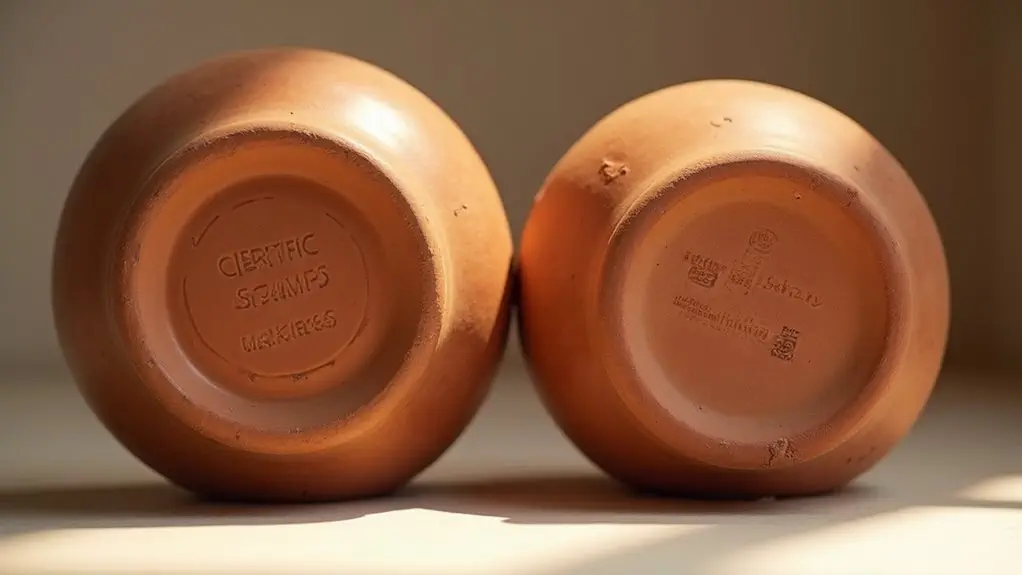
When you're shopping for handmade pottery, you'll want to look beyond the surface beauty to understand what those important safety labels are telling you.
You'll notice that even pottery marked "lead-free" isn't always what it claims to be, so it's essential to check for reliable certifications from recognized testing organizations. Food-safe glazes must be verified by manufacturers to ensure safety for kitchenware and dining pieces.
Knowing how to decode warning labels, such as "Not for Food Use" or "Decorative Only," can protect you and your family from potentially dangerous lead exposure in seemingly innocent pottery pieces.
Decoding Pottery Warning Labels
Understanding safety labels on pottery can mean the difference between decorative art and potential health hazards. When you're exploring modern pottery design and experimenting with glazing techniques, it's important to know what those stamps on the bottom of your pieces are telling you.
Here's what you'll typically find on pottery warning labels:
- Clear statements like "Not for Food Use" that indicate the piece is purely decorative
- Specific warnings about potential food contamination
- Information about lead content or other hazardous materials
- Instructions for proper use and care
You'll usually spot these warnings stamped right on the pottery's bottom. Don't ignore them – they're not just legal requirements but vital safety guides that protect you and your family from potential lead exposure and other risks.
Finding Reliable Safety Certifications
Looking for reliable pottery safety certifications can feel like charting a maze of acronyms and seals.
Don't worry – you'll find your way through with the right guidance. The FDA certification and EU standards are your gold standards for lead and cadmium safety in ceramic tableware. They're backed by rigorous testing and strict safety compliance requirements. Always make sure to avoid handling raw powder materials when examining pottery pieces.
When you're shopping, look for the AP (Approved Product) seal from ACMI's certification programs – it's your signal that the pottery's been thoroughly evaluated for safety.
You'll also want to check for "Lead-Free" and "Cadmium-Free" labels that meet FDA guidelines. If you're buying pottery for kids, make sure it comes with a General Conformity Certificate (GCC) – it's not just a nice-to-have, it's required by law.
Protecting Your Family
To protect your family from lead-contaminated pottery, you'll need to take specific preventive measures both when buying and using ceramic dishware.
When it comes to pottery safety and family health, being proactive is your best defense against potential lead exposure. There is no safe level of lead exposure according to health experts.
Here's your action plan to keep your loved ones safe:
- Skip those tempting, brightly colored pieces from flea markets or street vendors, no matter how beautiful they may be.
- Test suspicious pottery using lead-testing kits before bringing them into your kitchen.
- Stick to decorative use only for traditional or handmade pieces you're unsure about.
- Choose ceramics from reliable manufacturers who follow FDA safety standards.
Global Safety Standards
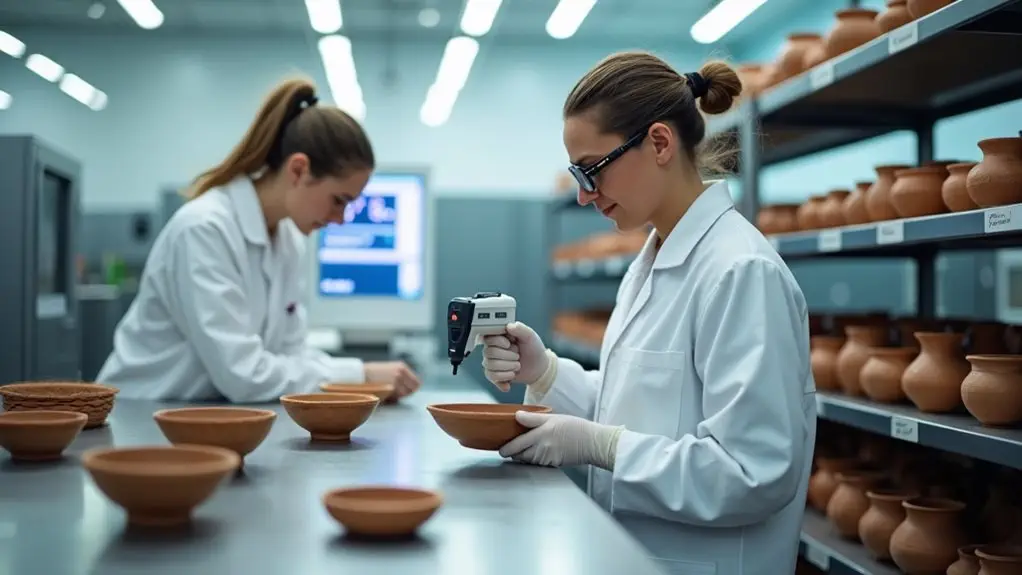
While family safety starts at home, international regulations shape how manufacturers produce pottery worldwide.
To combat lead exposure, global regulations now require separate facilities for lead-free pottery production, thorough kiln cleaning, and rigorous testing procedures.
You'll find that countries like Mexico, Ecuador, and Turkey face heightened scrutiny due to traditional pottery-making methods that often incorporate lead glazes.
That's why the FDA collaborates with international partners to promote safer production techniques and enforce strict standards.
If you're curious about a piece's safety, manufacturers must label their products accurately – anything marked "Lead Free" must meet FDA's stringent requirements.
These standards aren't just red tape – they're your safety net.
Modern pottery producers are innovating with lead-free alternatives while preserving the artistry you love.
Alternatives to Questionable Pottery
Safe alternatives to questionable pottery abound in today's market.
When you're looking for safe pottery alternatives, you'll find plenty of eco-friendly options that won't compromise your health or style. Modern manufacturers have developed innovative solutions that combine safety with aesthetic appeal. Using pottery from unknown sources can expose you to dangerous lead contamination.
Here are four fantastic alternatives you can trust:
- Corelle's Winter Frost White Collection, featuring lead-free glass that's practically unbreakable
- East Fork's certified lead-free ceramics, perfect for the modern kitchen
- Duralex's tempered glass products, made in France with impeccable safety standards
- Emerson Creek Pottery's non-toxic pieces, crafted right here in the USA
You'll love that these alternatives aren't just safe – they're also stylish and durable.
Whether you choose glass, stainless steel, or certified lead-free ceramics, you're making a smart choice for your family's health.
Final Thoughts
Like a watchful guardian protecting your family's health, you're now armed with the knowledge to make safer pottery choices. You'll know when to embrace that beautiful handmade piece and when to pass it by. Remember, there's no need to toss out all your cherished ceramics – just test suspicious items, follow safety guidelines, and enjoy your pottery collection with peace of mind. Your home can still shine with artistic charm while staying lead-free.




